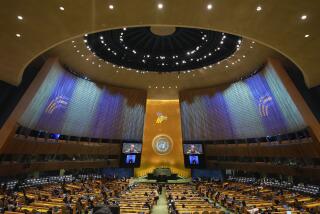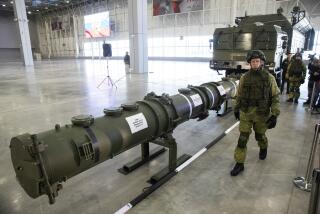Test Ban Would Sustain the Promise of INF Treaty
- Share via
Mikhail S. Gorbachev has unleashed a profound transformation of a system that is deemed by most experts to be stagnant, sclerotic and immutable. Through his policies of perestroika and glasnost, Gorbachev is taking the chill out of the Cold War and promises a profound transformation of international relations. Gorbachev’s policies will also profoundly affect American society.
To understand this ongoing process requires an appreciation that two interlinked organisms have been fueling the arms race: The U.S. military-industrial complex and Soviet paranoid secrecy. Each was feeding on, and surviving because of, the other. Gorbachev’s glasnost is now disrupting this unwholesome symbiosis. The U.S. military-industrial complex can resist almost any challenge, but it cannot survive large doses of glasnost.
The initial step in the unfolding drama is the intermediate-range nuclear-force treaty to be signed during next week’s summit meeting. For the first time nuclear weapons are to be dismantled by agreement. Although only 4% of the nuclear arsenals will be eliminated, this nonetheless constitutes an unprecedented step away from the brink of nuclear holocaust. It will help establish the psychological framework for further substantive progress. While there is a ray of hope, we should not grow ecstatic. Earlier arms-control accords only brought forth more and deadlier nuclear weapons. Will this be the case with INF? The arms race now threatens to go into the limitless expanses of space with “Star Wars” weapons waiting in the wings. What can be done to ensure that the failures of the past are not repeated?
A giant step forward is within our grasp. At a meeting with physicians in Moscow this past June, Gorbachev told us that he would resume a nuclear testing moratorium “tomorrow” if the United States also stops testing. This is no idle promise: Gorbachev persisted in a unilateral moratorium for 18 months in 1985 and 1986 despite more than 20 U.S. tests during that period. Nuclear testing drives the arms race and is required for the development of new generations of ever more sophisticated and more dangerous nuclear weapons--weapons that serve no purpose and increase fear, distrust and suspicion and threaten global genocide.
Negotiations on a comprehensive test-ban treaty, suspended by President Reagan in 1981, have finally resumed in Geneva. The sincerity of both sides should be tested by demanding a mutual moratorium on nuclear testing while the negotiators are at work. As the Chinese proverb says, “The journey of a thousand miles begins with a single step.” INF can be that first step that serves as a catalyst for an agreement to ban nuclear testing.
Where does the journey of a thousand miles ultimately lead? Oddly enough, Reagan and Gorbachev agree on where it should lead. Both are avowed abolitionists. Reagan sounds the radical when it comes to nuclear weapons. He called for their abolition in his second inaugural address, and agreed to their abolition when meeting with Gorbachev in Reykjavik. Reagan and Gorbachev are right. The goal of the journey is, and should be, the abolition of nuclear weapons.
Rather than dismissing abolition as impossible, we must plan the difficult journey ahead, and a test ban is the next essential step.
The fact that nuclear weapons cannot be dis-invented does not mean that they cannot be abolished. Step by step, measure by measure, we may find that what once seemed impossible now seems plausible. But no further step will be taken unless people everywhere demand that their voices be heard on an issue that concerns their very survival. The INF accords would not have been possible without the aroused concern of millions demanding substantive steps to reduce the nuclear peril. The summit meeting fosters hope, but it must never be forgotten that hope without action is hopeless.
More to Read
Sign up for Essential California
The most important California stories and recommendations in your inbox every morning.
You may occasionally receive promotional content from the Los Angeles Times.










